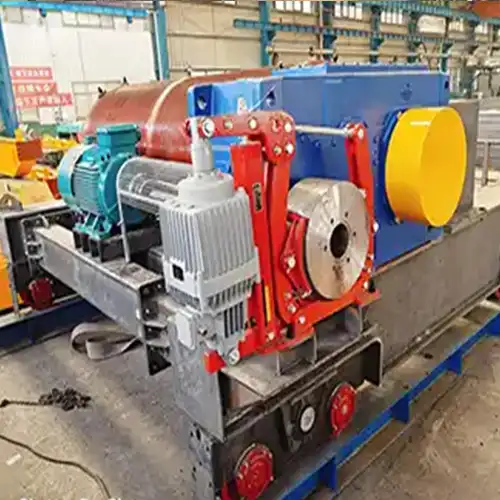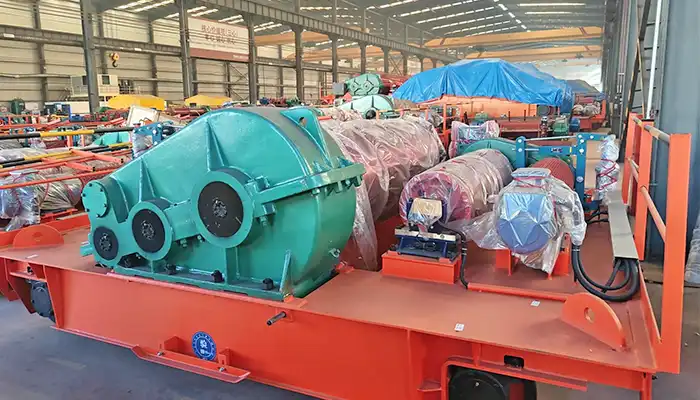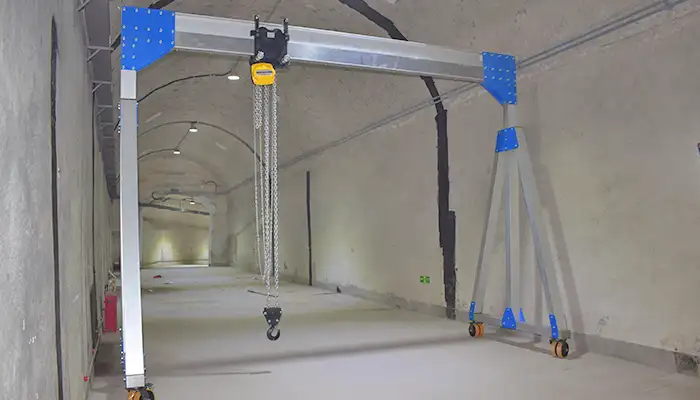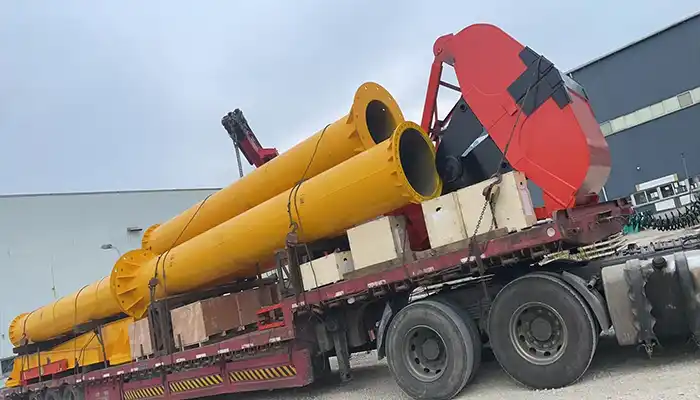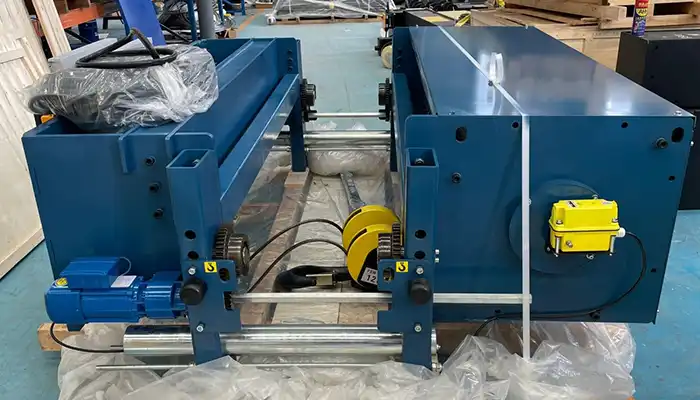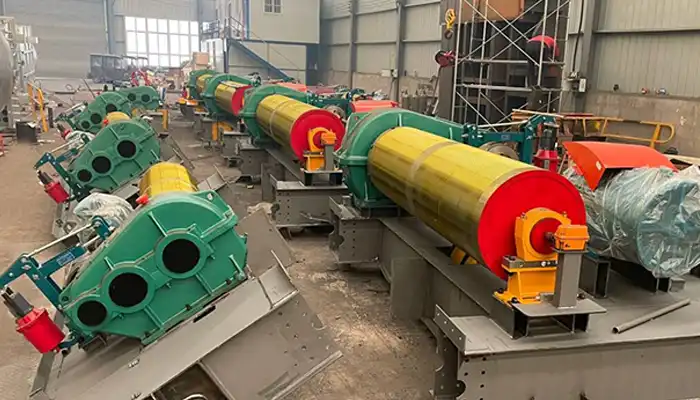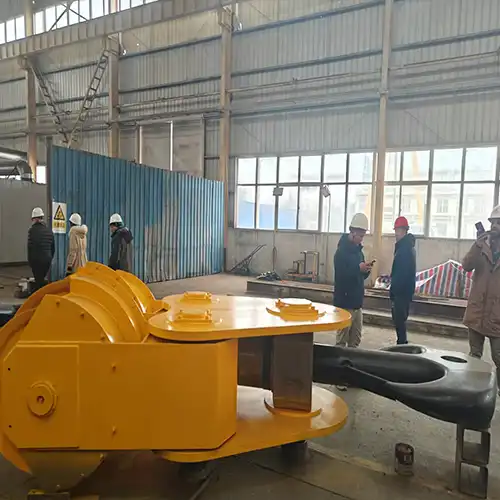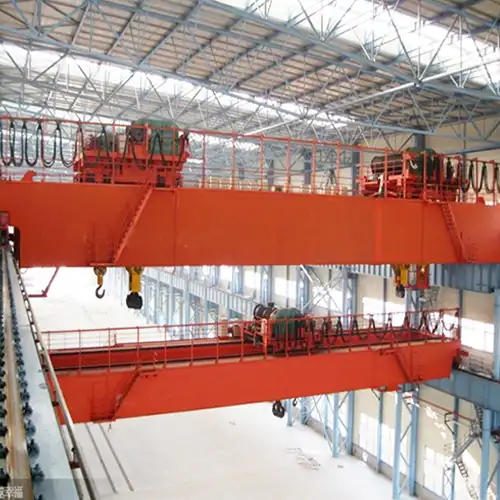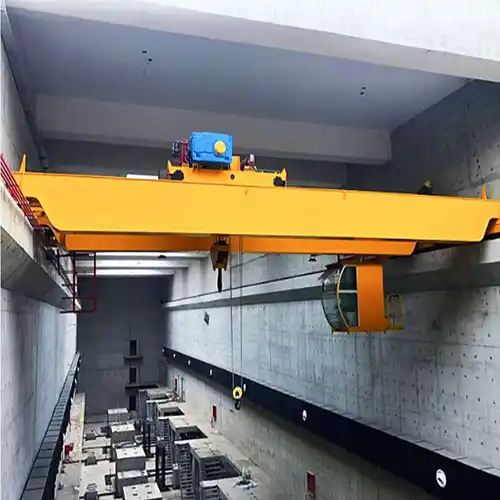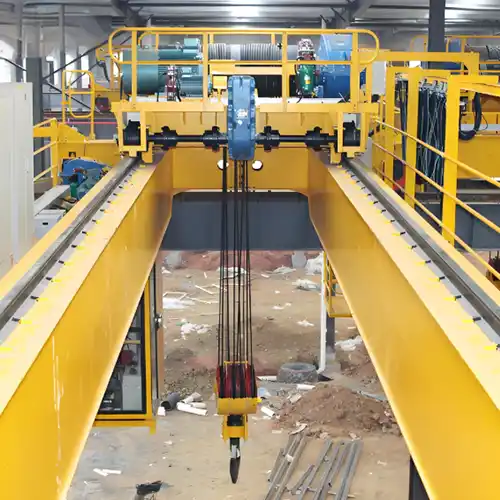150 Ton Open Winch Built-Up Hoist for Heavy Duty 2 Girder Cranes
Open winch for heavy industrial overhead cranes, high precision, durability & safety with a 150-ton built-up hoist system. Get heavy duty crane open winch!
Category: Heavy Duty & Large Capacity
Your Trusted Heavy Duty Open Winch Hoist Manufacturer & Supplier
Double Girder Crane 150 Ton Open Winch Built-Up Hoist
A powerful lifting solution for heavy industries, offering precision, durability, and safety with a 150-ton built-up hoist system.
Overview of Double Girder Cranes with Open Winch Trolley
Double girder cranes are a popular choice for heavy-duty lifting tasks in various industries. These cranes have two main girders, which give them the strength to lift very heavy loads, often in the range of several tons. The open winch trolley, mounted on the crane, is where the hoisting mechanism is located. It moves along the girder to lift or lower loads.
These cranes are essential for lifting heavy materials like steel beams, ship parts, and machinery components. Their design provides stability and power, making them suitable for both high-capacity and precise lifting.
Key Features of the Open Winch Trolley and Built-Up Hoist System
- Powerful Hoisting System: The built-up hoist is designed to lift extremely heavy loads, like 150 tons. It is strong, reliable, and built for tough environments.
- Efficient Load Handling: The open winch trolley provides smooth operation, enabling quick and safe lifting. It ensures the heavy load moves precisely along the crane's beam.
- Safety Features: With overload protection, fail-safe brakes, and other safety mechanisms, this system ensures both operator and load safety during operation.
- Durable Construction: Made with high-quality materials, the hoist and trolley are designed for heavy-duty use, even in demanding environments like steel mills or shipyards.

Purpose of 150 ton Built-Up Hoists
The 150 ton open winch trolley is designed specifically for heavy lifting. It's meant to handle massive loads that other hoists or cranes might struggle with.
This type of hoist plays a crucial role in industries that require the lifting of extremely heavy materials, such as steel, ship parts, or large machinery. It offers the strength to handle these tasks and does so with efficiency and safety.
The built-up hoist, combined with the open winch trolley, ensures smooth, controlled lifting, even in tough conditions. It's an essential tool for maximizing productivity and safety in high-capacity lifting operations.
Key Features of 150 ton Open Winch Trolley with Built-Up Hoist
Lifting Capacity and Performance
The 150 ton open winch trolley with built-up hoist is built to handle extremely heavy loads. It's designed for high-capacity applications where precision and strength are required.
- Heavy-Duty Lifting: This hoist can easily lift up to 150 tons, making it suitable for industries like steel mills, shipbuilding, and heavy machinery manufacturing.
- Fast Lifting Speeds: The hoist's powerful motor ensures that it can lift and lower loads quickly, saving time and increasing operational efficiency.
- High Duty Cycles: It's designed to work continuously, providing a reliable performance for industries with high-volume lifting needs. This means it can lift heavy loads multiple times a day without showing signs of wear.
- Smooth Load Handling: With advanced technology, the hoist ensures smooth lifting even under maximum load, preventing jerks or sudden movements that could damage materials.
Design and Construction
The design and materials used in the 150 ton open winch trolley are made to withstand tough working conditions.
- Durable Materials: The trolley and hoist system are built using high-strength steel and other alloys, ensuring that they can handle the stress and wear of lifting extremely heavy loads over long periods.
- Weather Resistance: The system is designed for use in harsh environments, such as steel mills or outdoor yards. The materials are resistant to corrosion and wear, ensuring a long lifespan even in tough conditions.
- Robust Construction: Every component of the system is built to last. From the motor to the winch mechanism, each part is designed with strength and durability in mind to handle the intense stresses of lifting heavy loads.
Safety Features
Safety is a key consideration in designing the 150 ton open winch trolley, and several safety mechanisms are in place to protect both the load and the operators.
- Overload Protection: The hoist is equipped with overload sensors that prevent lifting beyond its maximum weight capacity. This is crucial to avoid equipment damage and ensure safe operations.
- Fail-Safe Brakes: The hoist is equipped with fail-safe brakes that automatically engage if there is a power loss or mechanical failure, ensuring the load doesn't fall.
- Emergency Stop Functions: The system includes an emergency stop feature that allows operators to immediately halt the operation in case of an emergency, reducing risks.
- Redundant Safety Systems: In addition to the primary safety mechanisms, there are backup systems in place to ensure continued safe operation. This redundancy ensures that the hoist can continue working without compromising safety, even if one safety system fails.
These features make the 150 ton open winch trolley a reliable and safe choice for lifting heavy loads in demanding environments.
Types of Open Winch Trolley Designs
European Style Open Winch Trolley
European-style open winch trolleys are known for their precision and modern features. They are built to meet strict European safety and quality standards, making them a top choice for many industries that need high reliability.
- Precision Engineering: Every part is carefully designed for smooth and efficient performance. This means better control, smoother lifting, and longer equipment life.
- Enhanced Safety Standards: European trolleys come with advanced safety features, such as redundant brakes, smart load monitoring, and emergency systems. They are often CE certified to meet European norms.
- Compliance with Regulations: These trolleys are built according to EN standards, ensuring they meet both safety and performance requirements for European and international projects.
Key Benefits:
- Compact Design: European trolleys often have a low headroom design, which is great for workshops with limited height.
- Ease of Maintenance: Components are modular and accessible, making inspections and repairs quicker and easier.
- Reliability: Built for high-frequency and heavy-duty use, they perform well even in tough environments, like continuous production lines.
Traditional Style Open Winch Trolley
Traditional open winch trolleys focus on simplicity and strength. They have been widely used for decades in heavy industries and are known for their rugged and straightforward designs.
- Simple and Robust Design: These trolleys are easy to understand and operate. Fewer complex systems mean less can go wrong.
- Cost-Effectiveness: Compared to European-style trolleys, traditional models usually have a lower initial cost and cheaper maintenance parts.
- Suitability for Heavy-Duty Applications: While simpler, they are more than capable of handling demanding lifting tasks in industries like steel manufacturing, mining, and shipyards.
Key Benefits:
- Adaptability: Traditional trolleys can be easily customized or modified to suit different lifting needs.
- Proven Performance: With a long history of use, these trolleys have shown their reliability across many sectors and under all kinds of working conditions.
Choosing between European-style and traditional-style open winch trolleys usually depends on your project requirements, budget, and the operational environment. Both designs have their strengths — it's about what fits your specific needs best.
How to Select the Right 150-Ton Open Winch Trolley for Your Use
Choosing a 150-ton open winch trolley is not a simple decision based only on lifting weight.
You must consider your real working conditions, the characteristics of your workshop, and the specific demands of your application.
A good match between the hoist and your needs will not only improve your daily operations but also extend the life of your crane system and reduce maintenance costs.
Let's go through it step by step.
Selecting Based on Application Requirements
Each type of industry has its own specific lifting challenges. Understanding your operation clearly helps you make a better choice.
Steel Mills
Steel mills deal with heavy and high-temperature materials such as billets, coils, and slabs. These loads require precise, reliable, and frequent lifting under tough working conditions.
For this type of work, a European-style open winch trolley is highly recommended.
- It offers better control of lifting speed, ensuring safe and accurate handling.
- It is designed for high-frequency, continuous operation without overheating.
- Its advanced control systems help reduce the risk of accidents caused by swinging or sudden load drops.
In steel mills, a mistake during lifting can cause damage to expensive materials and even risk worker safety. Therefore, investing in a more precise and durable system makes long-term sense.
Shipbuilding
In shipbuilding, the loads are typically extremely large and heavy, such as ship blocks, engines, and hull sections.
However, the lifting itself may not always require fine positioning or extremely high frequency.
For this situation, a traditional-style open winch trolley is often enough.
- It is simple, robust, and easy to maintain.
- It can handle very large loads without needing complex control systems.
- It is often more economical for shipyards where heavy lifting happens but with lower demands for speed control and load precision.
That said, if your shipyard specializes in modern, modular construction methods where parts must fit perfectly, a European-style trolley with better micro-movement control would be more suitable.
Heavy Manufacturing
Factories that produce heavy machinery, large structural parts, or industrial equipment need very reliable and safe lifting systems.
Here, choosing a European-style open winch trolley is usually the better option.
- It provides consistent, smooth lifting performance for delicate and valuable machinery.
- It minimizes the chance of accidents or sudden breakdowns during critical operations.
- It allows for easier future upgrades with automation or smart factory technologies.
In heavy manufacturing, downtime caused by lifting equipment failure can cause serious production delays and financial losses. Therefore, focusing on long-term performance rather than just initial cost is the smarter strategy.
Selecting Based on Workshop Features
Not every open winch trolley can fit every workshop. You must carefully check your building's structure, space, and supporting systems before deciding.
Headroom and Space Limitations
Workshops often have restrictions on vertical space. If your roof height is limited, it is very important to choose the right trolley design.
- European-style open winch trolleys are designed with compact, low-headroom structures.
- They allow you to lift heavier loads higher without major building modifications.
- This can save you from costly renovations or new construction projects.
Traditional-style trolleys usually require more space above the crane beams, which can limit lifting height in low buildings.
Building Strength and Crane Runway Capacity
A 150-ton crane is not only about the weight of the material you lift but also about the crane's own weight, including the trolley.
Your building structure, runway beams, and foundations must be strong enough to handle these loads safely.
- European trolleys often use lighter, optimized designs that place less stress on the building structure.
- Traditional trolleys are usually heavier and may require stronger crane runways.
If your building has limited load-bearing capacity, choosing a lighter but equally strong trolley is critical for long-term safety and cost control.
Power Supply Setup
Large hoists require stable and sufficient electrical power. Before making a selection, you need to check the available voltage and frequency at your site.
- European open winch trolleys are typically designed for 400V, 50Hz supply, common in many countries but not everywhere.
- Traditional trolleys often offer more flexible motor configurations, making it easier to match non-standard power supplies.
Selecting a trolley compatible with your existing power conditions avoids the need for expensive electrical system upgrades.
Selecting Based on Lifting Requirements
The way you plan to use the hoist in daily operations also plays an important role.
Lifting Frequency and Duty Cycle
If you need to lift heavy loads many times a day, you must choose a hoist designed for high-duty cycles.
- European-style trolleys are built to handle frequent, high-speed lifting with minimal wear and tear.
- They often have better thermal protection, allowing them to work longer without overheating.
For operations with only occasional heavy lifts, a traditional trolley could be a more cost-effective solution.
Load Type and Handling Needs
The shape, stability, and sensitivity of the load also matter.
- If you are handling regular-shaped and durable materials, a traditional trolley can perform well.
- If you are moving delicate machinery, equipment, or loads that require gentle and precise positioning, a European trolley with better speed control is safer and more efficient.
Working Environment
Dust, humidity, high temperatures, and other tough conditions can shorten the lifespan of your hoist system if it is not properly protected.
- European-style open winch trolleys usually come with better environmental protection features, such as sealed motors, anti-corrosion coatings, and better enclosures for electrical parts.
- Traditional trolleys can be made more durable with add-ons, but you need to confirm that these upgrades are available.
Choosing the right protection level for your environment can prevent costly breakdowns and extend the life of your equipment.
When selecting a 150-ton open winch trolley for your double girder crane, you should look beyond the lifting capacity alone. Think about how often you lift, what you lift, where you lift, and the condition of your building and power systems. It's about finding the best match between performance, safety, cost, and long-term reliability.
Table of European Style Open Winch vs. Tradtioanl Style Open Winch
| Selection Factor | European-Style Open Winch Trolley | Traditional-Style Open Winch Trolley |
|---|---|---|
| Application | High-precision, frequent lifting (e.g., steel mills, heavy machinery) | Simple, heavy lifting with less precision (e.g., shipbuilding) |
| Lifting Frequency | High duty cycle, continuous operation | Moderate duty cycle, occasional heavy lifting |
| Load Handling | Sensitive or valuable loads requiring precise control | Large, regular-shaped heavy parts |
| Workshop Headroom | Low-headroom design, fits limited vertical space | Requires more headroom |
| Building Load Capacity | Lighter trolley design, lower building stress | Heavier design, stronger runway needed |
| Power Supply | Standardized (typically 400V/50Hz) | Flexible motor options for various voltages |
| Environmental Protection | Better protection (sealed motors, anti-corrosion coatings) | Basic protection, upgrades optional |
| Ease of Maintenance | Easier access, modular parts | Simpler structure, straightforward maintenance |
| Cost Consideration | Higher initial investment, long-term savings | Lower initial cost, higher possible wear and tear |
Applications of 150-Ton Open Winch Trolley with Built-Up Hoist
Heavy Lifting in Steel Mills
In steel mills, materials like billets, coils, and plates are extremely heavy and need careful handling. A 150-ton open winch trolley with a built-up hoist makes this possible.
- Smooth lifting is important to avoid damaging valuable steel products.
- Precise control ensures that materials are positioned exactly where needed during production.
- The hoist's strength and stability help maintain continuous production without downtime.
This makes it a critical piece of equipment in modern steel manufacturing.
Shipbuilding
Shipbuilding involves assembling massive and sometimes awkwardly shaped parts. Moving these safely is a big challenge.
- Large components such as engine blocks, hull sections, and deck parts need safe and steady lifting.
- A 150-ton open winch trolley can handle these loads easily, even when they are bulky or unevenly shaped.
- Using a precise hoist system reduces the risk of accidents and damage, which is very important for shipbuilding quality and worker safety.
Both European-style and traditional trolleys can be used here, depending on how precise or simple the lifting work needs to be.
Heavy Manufacturing and Machinery Handling
In heavy manufacturing, factories deal with big machinery parts and structural elements daily. Moving these safely and quickly improves productivity.
- A strong open winch hoist makes it possible to lift, move, and assemble heavy machines without unnecessary delays.
- Smooth lifting helps avoid damaging high-value components like motors, gearboxes, and frames.
- Built-up hoists also allow for better scheduling since they are reliable and built for high-frequency use.
This makes them a smart investment for manufacturers aiming to scale up their operations.
Mining and Construction
Mining and construction projects involve moving massive, often irregular loads, sometimes in tough outdoor conditions.
- Equipment like crushers, drilling rigs, and support frames are extremely heavy and need careful positioning.
- A 150-ton open winch hoist ensures that lifting and placing these components are done safely and efficiently.
- Even on rough sites, the strong and durable construction of a built-up hoist withstands harsh conditions.
This reliability is key to keeping projects on time and minimizing equipment damage.
Conclusion
Choosing the Right Open Winch Trolley for Your Needs
When selecting a 150-ton open winch trolley, it's important to start with your actual needs. Not all lifting tasks are the same, and not all trolleys fit every situation.
- Think about your lifting requirements first. How heavy, how frequent, and how precise does the lifting need to be?
- Look at your workshop or site features. How much space do you have? What about headroom and runway beam strength?
- Consider your operational needs. Do you need high safety standards, faster lifting speeds, or a more affordable solution?
Choosing between European-style and traditional-style trolleys depends on the answers to these points.
- European-style open winch trolleys are a better choice when you need high precision, fast cycles, and advanced safety features.
- Traditional-style open winch trolleys are a good match if your lifting tasks are more straightforward and cost control is a big priority.
The right choice saves you more than money — it protects your equipment, workers, and operation flow.
Getting the right hoist and trolley system is not just about lifting heavy loads. It's about lifting them safely, efficiently, and reliably every day.
- Make sure the hoist capacity matches your real-world loads.
- Pick a system with the right level of safety features for your working environment.
- Balance your investment between short-term costs and long-term performance.
Contact us to get more information 150 ton open winch trolly for heavy duty double girder crane !
Main Projects
Related Products
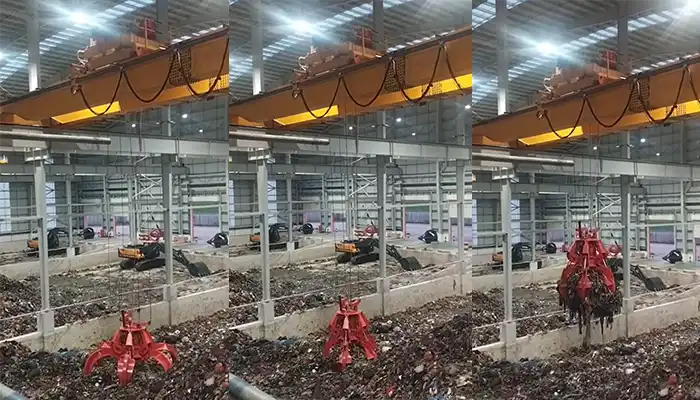
Supplied three grab bucket crane kits to Indonesia, enhancing garbage handling efficiency with high load capacity and reliable performance.
Free consultation to Confirm Parameters & Specifications and Get
Latest Crane Price & Crane Rate.
- Types of overhead cranes : _______?
- Optional: Overhead travelling crane, goliath gantry crane,Slewing jib crane, Single girder or double girder crane,small portable crane or kbk crane, etc.
- Capacity of overhead crane: _______?
- Optional: 0.25ton, 0.5 ton, 1 ton, 2 ton, 3ton, 5 ton, 10 ton,15ton, 20ton, 25 ton, 30ton,35ton, up to 550ton, etc.
- Crane span & lifting height : _______?
- Crane travelling length : _____?
- Control of overhead crane:_______?
- Optional: pendant/ remote/cabin control
- Voltage supply of overhead crane:_____?
- Eg,: 380V50/60HZ,3Phase or others,etc.
- Application/usage of crane:_______?
- Eg,: Steel mill, ,injection mold, cement,stone, concrete,granite, general manufacturing, etc.
Just leave a message via the contact form and our hoist and crane engineer will contact you with in 24working hours.
Get In Touch
